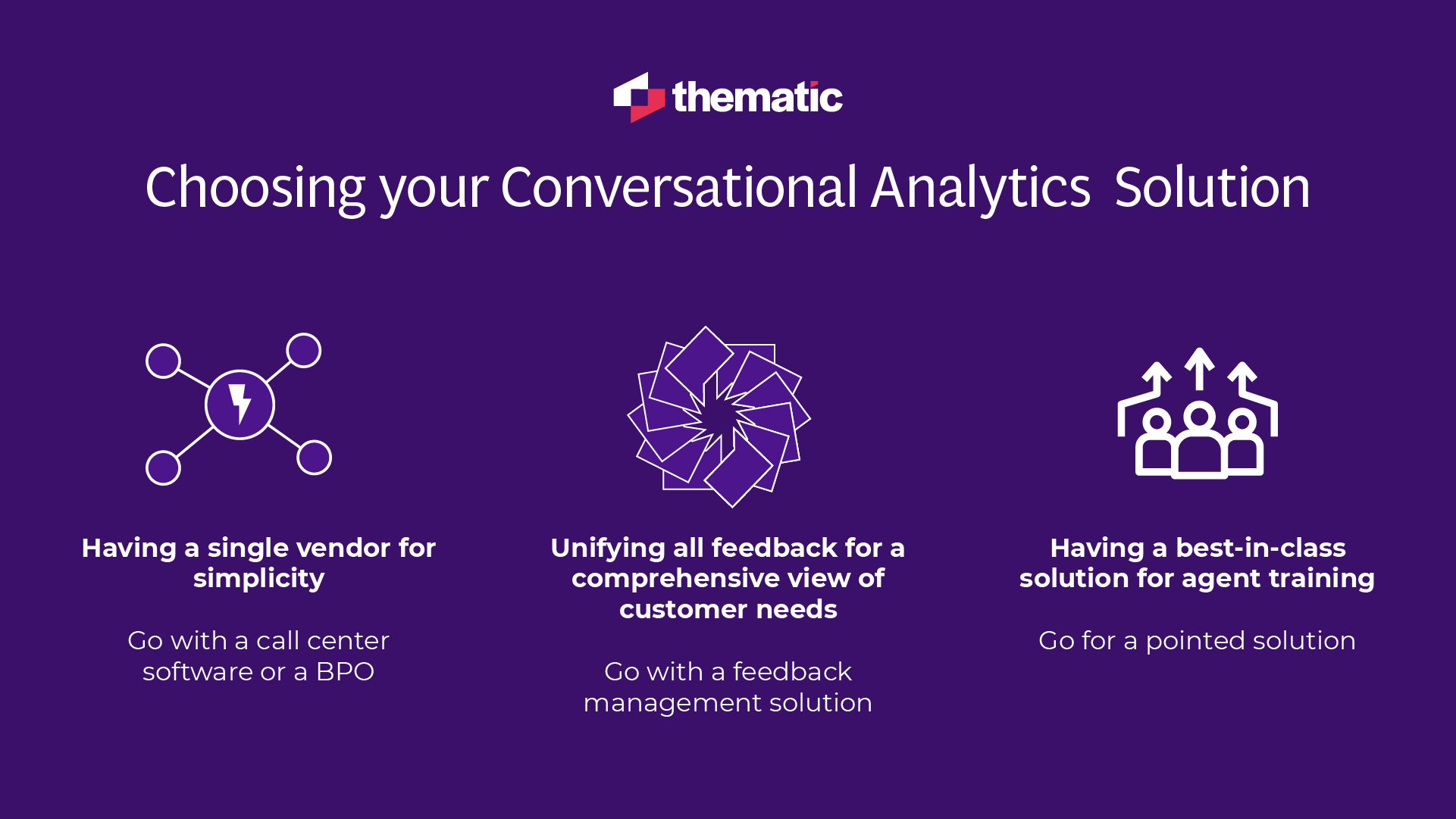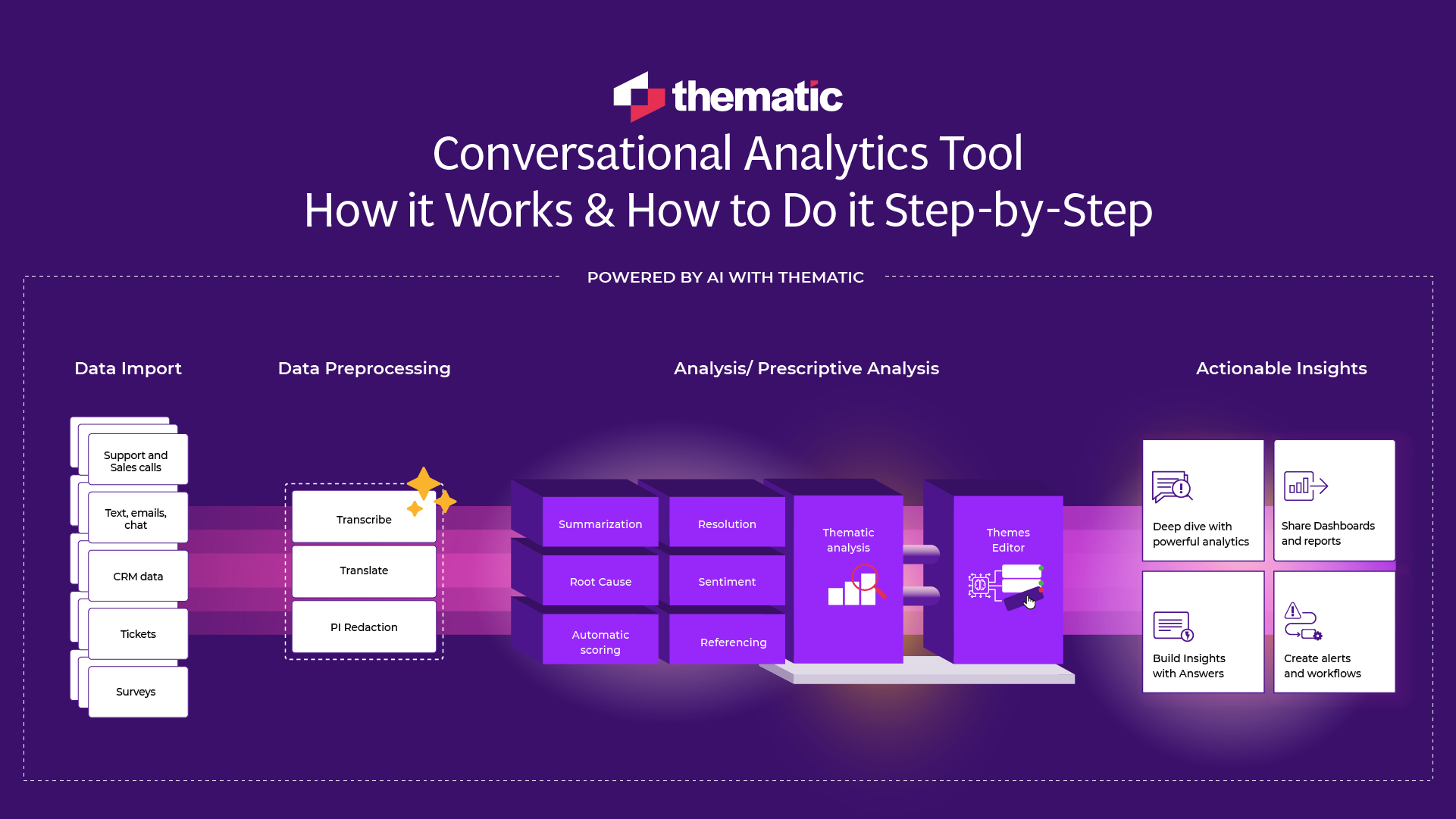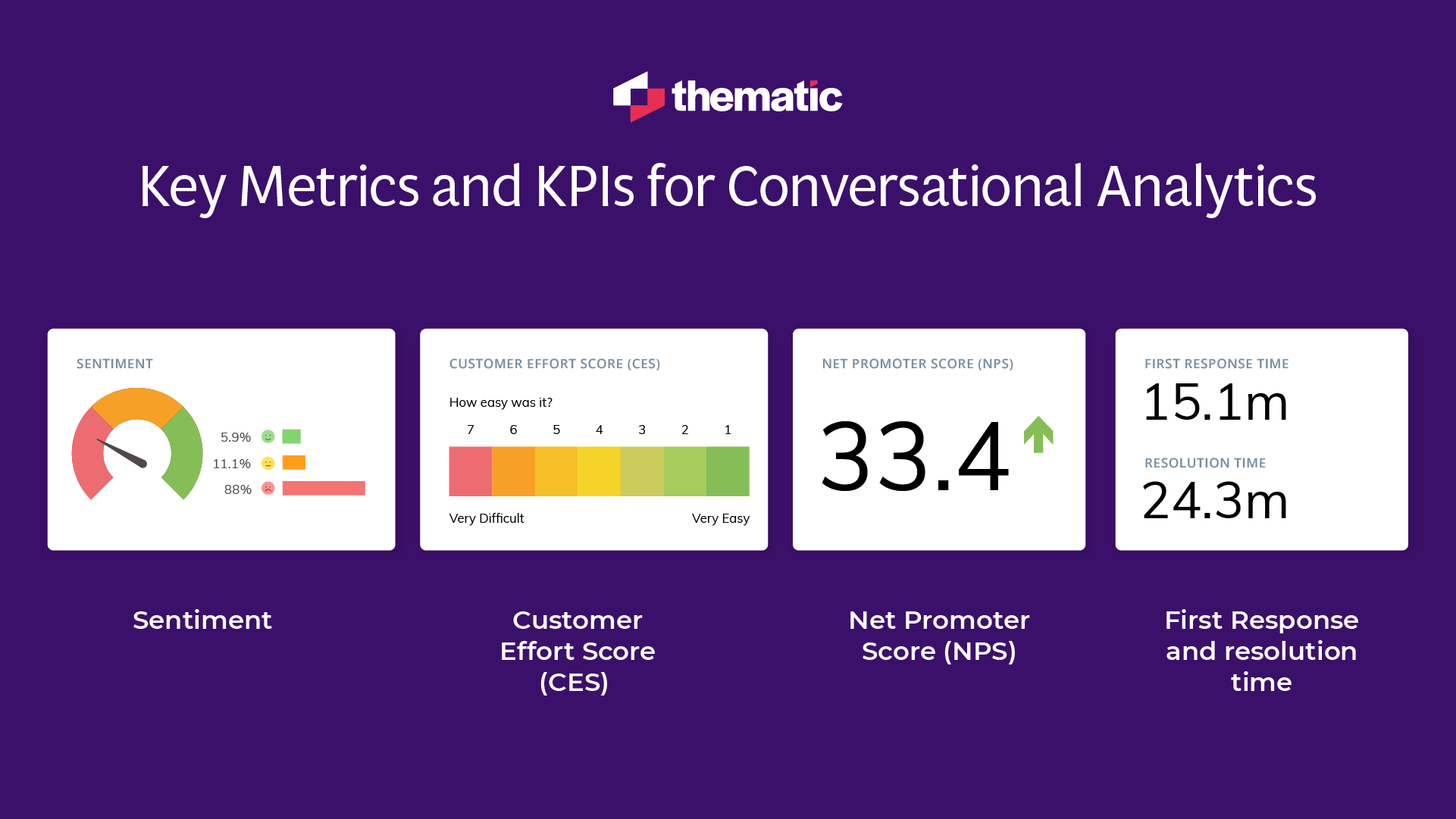.webp)
Conversational analytics uses AI to turn customer interactions into real-time insights, improving support, experience, and decision-making.

Every day, conversations between businesses and customers happen across chatbots, social media, emails, and messaging apps. That’s a lot of valuable data—but without the right tools, it’s just noise.
Conversational analytics, using AI-powered techniques like natural language processing (NLP) and machine learning, is now helping businesses unlock insights hidden in these conversations. Whether it's identifying trends in customer feedback or improving chatbot responses, conversational analytics turns raw text into actionable data.
In this guide, we’ll break down how conversational analytics works, why it matters, and how to implement it in your business—so you can make smarter, faster decisions to improve customer experience and products. Let’s dive in.
Traditional contact centers mainly rely on phone calls to serve customers. They track numbers like call length, wait times, and first-call resolution using text analytics methods to measure efficiency. But because this data is handled separately for different channels, businesses only get part of the picture.
But conversational analytics is changing the landscape. Rather than looking only at past phone call data, it analyzes conversations across voice, chat, email, and messaging apps—all in real-time.
Here’s the main difference:
With conversational analytics, businesses can respond faster, improve support, and lower costs—things that traditional analytics just can’t do.
Both speech analytics and conversational analytics help businesses understand customer conversations, but they focus on different things.
In the past, speech analytics mostly relied on simple keyword tracking. But with AI-powered conversational analytics, businesses now get a fuller picture of interactions—helping them improve customer experience, refine processes, and make smarter decisions.
Speech analytics and conversational analytics both extract insights from customer conversations, but with a slightly different focus.
Speech analytics assesses the acoustic elements of speech – tone, pitch, speed – as well as the words spoken during customer service calls. Its main use is to measure call quality and agent performance.
Conversational analytics goes beyond voice to include chats, texts and other forms of communication. The analysis includes the context of the interaction, the sentiment and intent behind conversations, as well as the acoustic properties.
Historically, speech analytics methods were simplistic, analyzing the text for keywords. With the rise of AI, conversational analytics provides a more complete view of interactions, to support the contact center in achieving it's goals.
Many contact center managers and QA specialists are shifting from speech analytics to conversational analytics—but it’s not just for them. Customer Experience and Research teams focused on Voice of the Customer (VoC) are also seeing its value.
VoC programs aim to capture what customers expect, like, and dislike—whether about a specific product, service, or overall experience. Traditionally, these programs relied on surveys and interviews, which only capture part of the picture.
Conversational analytics changes that. Instead of waiting for survey responses, it analyzes real customer conversations across calls, chats, and messages—giving VoC teams a more direct and complete view of customer needs.
By filling in the gaps left by traditional methods, conversational analytics helps businesses break down silos, uncover deeper insights, and make better customer-driven decisions.
Conversational analytics software helps businesses analyze customer interactions across multiple channels—phone calls, chats, social media, and emails—to uncover valuable insights.
Using AI, NLP, sentiment analysis, and machine learning, this software helps businesses understand customer emotions, identify key trends, and make data-driven decisions to improve customer satisfaction and efficiency.
Conversational analytics can be part of a larger platform or a standalone solution:
For pointed solutions designed specifically for conversational analytics, tools like Observe.AI, Tethr, and CallMiner provide in-depth insights focused on agent training and optimization.
When choosing the right solution, consider what matters most:

Before committing to a conversational analytics solution, always run a test on your data to see if it’s worth the setup and training effort.
Look for three key factors:
A good solution should save time, provide real value, and be easy for your team to use—so testing before you invest is a smart move.Also remember that finding the right conversational analytics tool depends on your goals—but the right one will help you drive better customer experiences and smarter decisions.
To get the best results from conversational analytics, start by choosing the right tool. Your choice will impact speed, accuracy, and ease of use.
In this guide, we’ll walk through the setup process using Thematic’s conversational analytics software—a powerful platform that uses AI to automatically categorize customer interactions and uncover hidden patterns and trends in conversations.
The first step in the analysis is data import—bringing in call recordings, chat transcripts, social media interactions, and more. A good tool ensures all customer conversations across different channels are collected in one place.
With Thematic, integrations seamlessly pull data from multiple sources into the platform, making sure no important insights are left out.
Once the data is in, it needs cleaning and preprocessing to ensure quality. This includes:
This step ensures that only relevant, high-quality data is used for analysis—so you get accurate, actionable insights without noise.
AI helps make sense of human language in customer conversations. It performs key tasks like:
Thematic takes this further by automatically summarizing conversations and categorizing them as Issues, Requests, or Questions. It also assigns key scores and metadata to help businesses measure performance:
These insights set the stage for deeper analysis.
Collecting data is perhaps the easiest part of the puzzle. What is challenging is making sense of the data, but conversational analytics makes it easy to understand data and act on. Thematic provides three ways to analyze data:
The goal? To help businesses spot patterns, trends, and anomalies, whether through frequency analysis, correlation studies, or causality detection. But insights are only useful if they’re accessible to the right people.
At Thematic, we believe every decision-maker should have direct access to insights, in the customer’s own voice—so they can make better, faster, customer-driven decisions.
AI doesn’t just analyze conversations—it can also suggest actions in real time. Prescriptive analytics uses machine learning to learn from past interactions and recommend the best next steps.
For example, Intercom can pre-draft responses for support agents, helping them reply faster. One company trained a large language model (LLM) on 500 past conversations, allowing AI to draft responses automatically. Agents could review and edit the responses, but in 50% of cases, they didn’t need to make any changes.
The result? Faster, more consistent customer service and reduced operational costs—without sacrificing quality.
At Thematic, we take this further with Generative AI. Instead of just providing answers, our AI can offer recommendations based on conversation trends. For example, if support agents rarely edit AI-generated responses, a self-help center could be introduced to let customers find answers instantly—reducing the need for human support.Prescriptive analytics can also analyze conversations in bulk and suggest solutions to common customer issues—helping businesses stay proactive, not just reactive.
Data alone doesn’t drive change—actionable insights do.
Once businesses have visualized data and AI-driven recommendations, the next step is applying those insights to real-world decisions. These could include:
By turning data into action, businesses can improve customer engagement, boost satisfaction, and drive long-term success.
The final step is closing the loop—measuring the impact of your actions and using that data to keep improving.
Traditionally, businesses closed the loop one customer at a time, responding to feedback individually. But with AI-powered conversational analytics, companies can now close the loop at scale.
For example, instead of just fixing an issue and moving on, businesses can proactively message groups of customers to let them know how their feedback led to improvements. This builds trust, loyalty, and stronger customer relationships.
By continuously monitoring results and adapting to new trends, businesses can stay ahead—ensuring their customer experience keeps evolving with real-time insights.

Success with conversational analytics starts with the right setup. Businesses need a smart platform, smooth integrations, and a trained team to turn conversations into insights. Before diving in, focus on choosing the right tool, connecting your systems, and ensuring data privacy—this sets the stage for real impact.
The first step is selecting a conversational analytics platform that fits your business needs. Look for solutions that offer:
It’s also important to choose a platform that integrates smoothly with your existing tech stack to avoid silos and inefficiencies.
For conversational analytics to deliver the full picture, it should be connected to all key customer data sources, including:
Look for tools with built-in connectors or APIs to ensure seamless data flow and synchronization across platforms. This will give you a unified view of customer interactions.
To get the most out of conversational analytics, your teams need the right skills. Provide training that covers:
Encouraging a data-driven culture will help employees leverage conversational analytics to improve customer experience and optimize business processes.
Conversational analytics must comply with strict data privacy regulations like GDPR (Europe) or HIPAA (U.S.). To stay compliant:
Following these steps will not only ensure compliance but also build customer trust—a key factor in long-term success.
To get the most value from conversational analytics, it’s important to track the right metrics and KPIs. These numbers help measure customer satisfaction, efficiency, and overall performance, giving businesses the insights they need to make meaningful improvements.
Sentiment Score helps analyze the emotional tone behind customer interactions. Using AI and contextual analysis, this metric classifies conversations as positive, negative, or neutral based on the words and phrases used.
Tracking sentiment scores helps businesses:
Customer Effort Score (CES) measures how easy or difficult it is for customers to resolve issues or complete interactions. A low effort score means a smoother experience, which directly links to higher satisfaction and loyalty.
By monitoring CES, businesses can:
Net Promoter Score (NPS) measures customer loyalty by asking:
"How likely are you to recommend this product or service?"
A high NPS means strong customer satisfaction and brand advocacy, while a low NPS could indicate retention risks.
Tracking NPS through conversational analytics helps businesses:
These are critical customer service metrics, as faster response and resolution times usually lead to higher customer satisfaction.
By tracking and improving these times, businesses can:

Conversational analytics goes beyond analyzing chats—it helps businesses improve service, streamline processes, and stay ahead of customer needs. Let’s look at some real-world applications and use cases of conversational analytics.
Conversational analytics is transforming customer service by analyzing voice and text conversations to:
With instant feedback, businesses can personalize responses, optimize support workflows, and resolve problems faster—leading to more efficient customer service operations.
In sales and marketing, conversational analytics helps businesses understand customer preferences, purchase intent, and engagement. By analyzing conversations, companies can:
This allows businesses to target the right audience with the right message at the right time—leading to better results.
Conversational analytics does more than improve service—it fuels product innovation. Analyzing real customer feedback helps businesses:
This ensures that product updates align with customer needs, improving usability and customer satisfaction.
Brand perception matters, and conversational analytics helps businesses track customer sentiment in real time. By analyzing the tone and emotions in conversations, businesses can:
By proactively monitoring conversations, businesses can strengthen their brand image and build long-term customer trust.
While conversational analytics offers powerful insights, businesses need to navigate a few key challenges to get the most value. From data quality to organizational adoption, overcoming these hurdles is essential for success.
One of the biggest challenges is ensuring high-quality data. Poor audio quality, slang, and unclear speech can disrupt speech analytics and lead to inaccurate results.
How to fix it:
Most customer conversations are unstructured, making them difficult to manage and analyze. Extracting valuable insights from large amounts of raw, free-flowing dialogue requires advanced AI and NLP techniques.
How to fix it:
AI models can inherit biases, leading to skewed customer insights. Ensuring fair and ethical AI is essential for accurate, unbiased decision-making.
How to fix it:
Adopting conversational analytics requires shifting traditional ways of working. Customer service teams used to older methods may resist change.
How to fix it:
AI-powered conversational analytics platforms help businesses make sense of customer conversations at scale. Instead of manually analyzing feedback, advanced AI and NLP can automatically detect themes, measure sentiment, and uncover trends—all in real time.
One example is Thematic, a platform that uses AI to analyze both text and voice interactions, helping companies quickly identify what drives customer behavior.
With reduced manual effort and increased accuracy, businesses can make faster, smarter decisions, and we all know what comes next—better customer experiences and stronger business outcomes.
Conversational analytics and AI are changing the way businesses talk to customers—making support faster, smarter, and more personal. As technology improves, companies will understand conversations better, automate responses, and build stronger customer relationships.
We’ve already seen big improvements in AI, NLP, and machine learning, helping businesses make sense of huge amounts of unstructured data. But the future holds even more exciting changes.
As AI gets better, conversational analytics won’t just make support more efficient—it will help businesses truly connect with customers in a meaningful way.
The future of conversational analytics is about making AI feel more human, providing instant insights, and putting customers first.
Want to see how it works?
Book a free guided trial of Thematic today.
Conversational analytics is the process of analyzing customer interactions—such as voice calls, chats, social media messages, and emails—to extract insights about behavior, preferences, and sentiment. Using AI-powered techniques like natural language processing (NLP) and machine learning, it can identify patterns, trends, and emotions in conversations. This helps businesses improve customer experience, enhance chatbot interactions, and optimize support operations by making data-driven decisions in real time.
Traditional analytics mainly focuses on historical data, such as past sales, customer surveys, or basic contact center metrics (e.g., call duration, resolution times). It provides insights that are often retrospective and fragmented across different communication channels.
Conversational analytics, on the other hand, works in real-time across multiple communication platforms (phone, email, chat, social media) and analyzes customer sentiment, intent, and behavior holistically. This allows businesses to respond proactively, improve agent performance, and personalize customer experiences.
Businesses that adopt conversational analytics can expect multiple benefits, including:
To successfully implement conversational analytics, businesses should follow these key steps:
Join the newsletter to receive the latest updates in your inbox.